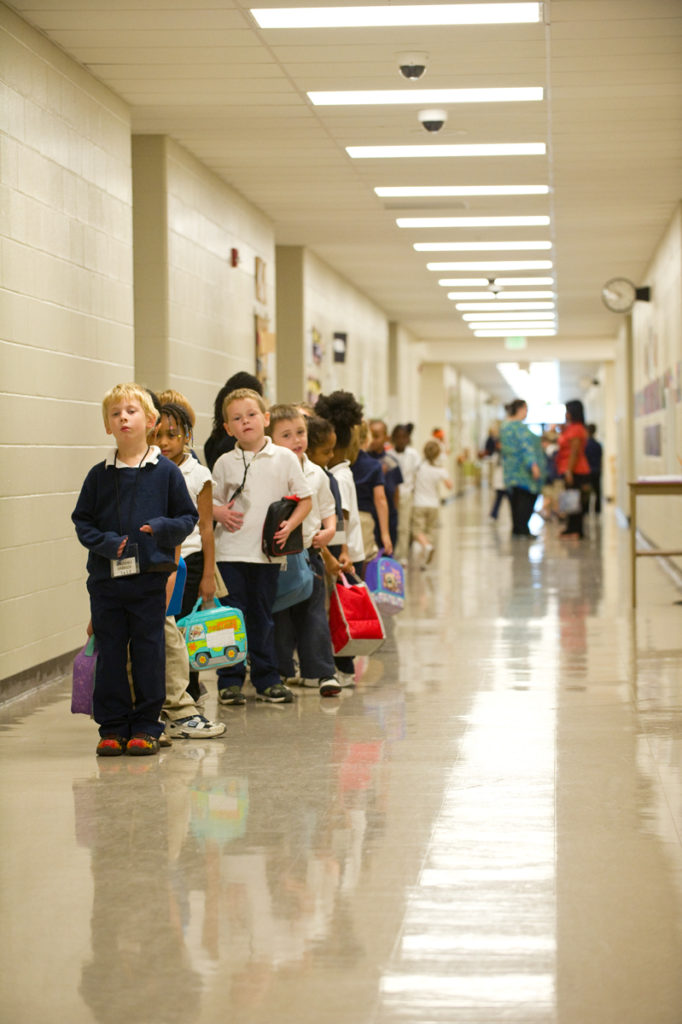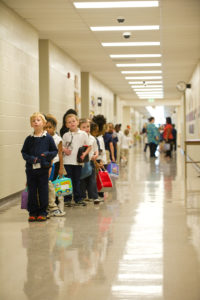
 A whistle blows, signaling that the day is about to begin. The children scamper to organize themselves into grade-level lines. On an adult’s signal, one line moves toward the building, pausing at the door. “We are about to go inside. What kind of waves will we use?” the adult asks the students. “Quiet, friendly waves,” one child volunteers. “Why those kind of waves?” A kindergartner replies, “Because there’s no room for big waves or big voices.”
A whistle blows, signaling that the day is about to begin. The children scamper to organize themselves into grade-level lines. On an adult’s signal, one line moves toward the building, pausing at the door. “We are about to go inside. What kind of waves will we use?” the adult asks the students. “Quiet, friendly waves,” one child volunteers. “Why those kind of waves?” A kindergartner replies, “Because there’s no room for big waves or big voices.”
With that, the adult asks, “Are we ready?” The children nod, and the line moves into the building and down the hallway. The adult walks at the back of the line.
As line after line of students enter the hallway and go toward their classrooms, they pass teachers standing outside the classroom doors. Each teacher greets the students with a smile and a wave or a high-five. The atmosphere is calm, quiet, and upbeat, setting a positive tone for the day.
This calm, friendly scene is typical of hallway transitions at Four Corners. Whether it’s going to specials, coming in from recess, heading to lunch, or leaving at dismissal, the students know what’s expected of them and, with few exceptions, live up to the expectations.
But this wasn’t always the case. Hallways at Four Corners used to be loud and rough. Students would push each other; fights would break out. Ten years ago, the faculty decided to make a change. They wanted the school, including its hallways, to be a welcoming and safe place for children to learn.
The teachers and staff agreed to start small and start with themselves. They agreed that each morning every adult would come into the hallway, greet one another, and greet the students coming into the building.
From there, they established expectations for hallway behavior for adults and students. Today, the expectations of adults are:
And the expectations of students are:
These rules are now part of the school culture. Kate Marion LaPierre, the school behavior specialist, says, “The kids themselves expect the school to be comfortable and calm. Problems in the hallway are rare and can be dealt with easily because everyone knows what should be happening.”
schoolwide routines, including those for hallways, are taught during the first weeks of school. Teachers go over the expected behaviors with their students, model them, and practice with their classes. When students return from school breaks, and at other times throughout the year, there might be refresher sessions. “The key is to keep practicing all year,” says first grade teacher Betsy Godin Conz.
It also helps to have a common schoolwide signal for quiet (two fingers raised in a “V” at Four Corners), as it gives everyone a way to remind each other about hallway behavior. One second grader says, “It can be sometimes hard to be quiet in the hallway, but you have to be because other people are learning. But sometimes people can’t help it and they talk. Then you have to put up the quiet signal because they forgot what to do or maybe didn’t know.”
Establishing clear expectations for hallway behavior benefits the whole school environment at Four Corners. “It is just one of the routines that the school has established to foster an environment where teaching and learning are respected,” says principal Gail Healy.
Setting: Public school in a small city in the Northeast
Number of students: 245
Grades: PreK–5
Number of staff: 49
Languages spoken by students: English, Russian, Moldovan, Spanish, Urdu